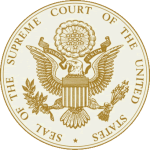- Industria: Government
- Number of terms: 836
- Number of blossaries: 0
- Company Profile:
The highest court in the United States. It's the judicial branch of the United States government. The U.S. Supreme Court has the ultimate appellate jurisdiction over all state and federal courts.
The United States is divided into thirteen circuits with a different court of appeals (see a map here). Eleven of the circuits are numbered first to eleventh. The District of Columbia has its own that hears many cases involving the federal government. The Federal Circuit’s jurisdiction is not geographic. Instead, it hears cases involving particular subject matters, such as patents and international trade. Courts of appeals are often referred to by the name or number of their circuit; for example, the “Ninth Circuit. ”
Industry:Government
Соединенные Штаты Америки состоит из тринадцати цепей с различными апелляционного суда (см. карту). Одиннадцать из цепей нумеруются первого до одиннадцатого. Округ Колумбия имеет свой собственный, что слышит многих случаях федеральное правительство. Федерального округа юрисдикция не является географическим. Вместо этого он слышит дел, связанных с конкретной тематики, как патенты и международной торговли. Апелляционные суды часто называют по имени или количество их цепи; например «девятого округа.»
Industry:Government
“Friend of the court” brief; a brief filed by a person, group, or entity that is not a party to the case but nonetheless wishes to provide the court with its perspective on the issue before it. The person or entity is called an “amicus”; the plural is “amici. ”
Industry:Government
An order is an instruction or direction issued by the Court. Unlike an opinion, which analyzes the law, an order tells parties or lower courts what they are to do. For example, the Court can order certiorari granted or denied in a case; it can order a lower court to re-examine a case in light of a new point or theory; or it can order the parties in a case to conduct oral arguments on a certain date.
Industry:Government
The calendar of cases that the Court is scheduled to hear is known as the docket. A case is “docketed” when it is added to the docket, and it is given a “docket number” at that time. The Court’s docket shows all the official actions in that case, such as the filing of briefs and orders from the Court.
Industry:Government
Календарь случаев что суд планируется услышать известен как реестр. Дело «подают», когда он добавляется к слушанию, и ему присваивается «реестр номер» в то время. Суда показывает все официальные действия в этом случае, например подачи записок и заказы от суда.
Industry:Government
Приказ — это инструкция или направления, выданного судом. В отличие от мнения, которое анализирует закон, приказ говорит сторон или нижестоящих судов они должны сделать. Например суд может приказать certiorari предоставляется или запрещается в случае; Он может заказать суда низшей инстанции пересмотреть дело в свете новой точки или теория; или он может заказать сторон в случае проведения устных аргументов на определенную дату.
Industry:Government
The term “remand” means “to send back,” and refers to just that – a decision by the Supreme Court to send a case back to the lower court for further action. When it remands a case, the Court generally includes instructions for the lower court, either telling it to start an entirely new trial, or directing it, for example, to look at the dispute in the context of laws or theories it might not have considered the first time around.
Industry:Government
Once the Supreme Court has granted certiorari in a case, each party has the opportunity to file merits briefs. Unlike the certiorari-stage briefs, which tell the Court why it should or should not take the case, the merits briefs tell the Court why each party thinks he deserves to win.
Industry:Government
Коли він вирішить випадок, суд взагалі питання думка, яка є комплексними та часто довгий шматок написання факти та історії справи підведенню підсумків і вирішенні юридичних питань, піднятих у справі.
Industry:Government
